OCTOBER 1, 2019 will mark the 70th anniversary of the founding of the People’s Republic of China. The early days of the PRC witnessed an impoverished and fragile state of the country where everything started from scratch and the level of educational development was very low. The national population was 540 million, with the illiteracy rate as high as 80 percent, and women took up 70 percent of illiterate population. Ninety percent of women nationwide were illiterate; the actual enrollment rate of primary schools was less than 20 percent; the number of students enrolled in higher education numbered only 117,000 and the national fiscal education funds accounted for only 1.32 percent of GDP. Since the total GDP level at that time was very low, the state’s funding for education was very poor.
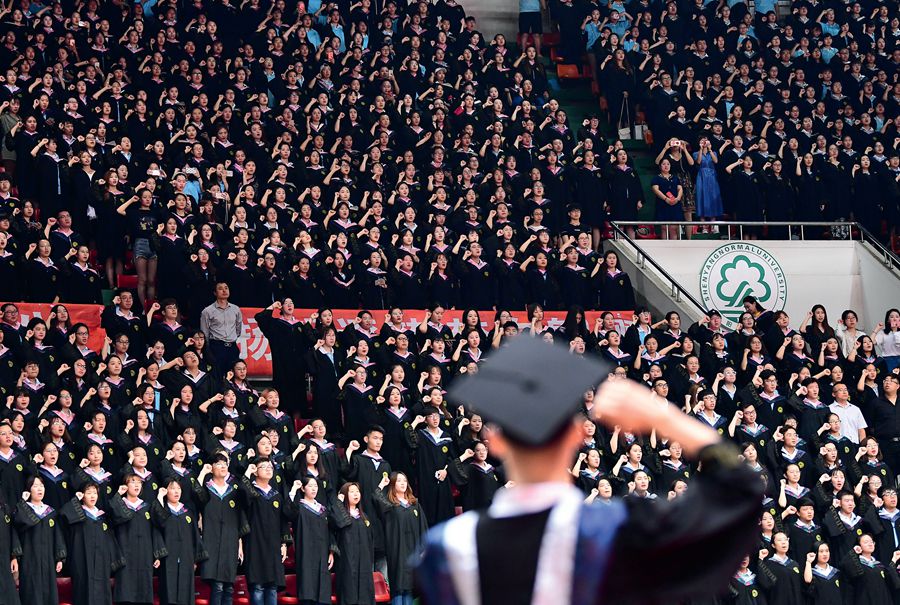
The 2018 graduation and degree awarding ceremony of Shenyang Normal University is held on June 25, 2018.
Over the past 70 years, China’s education system has gone through a glorious but difficult transformation. It mainly has had two important historical periods of restoration and exploration of educational undertakings during the period of socialist construction from 1949 to 1978 and reform and development of socialist education with Chinese characteristics after the reform and opening-up in 1978. In the past 70 years, especially since the reform and opening-up in 1978, China’s education has made great historic achievements, transforming a large country with the illiteracy rate at 80 percent into a country rich in talents, and also converting the huge population burden into the human resources advantage that strongly supports the country’s reform and opening-up. China aims to achieve educational modernization by 2035, with easy access to quality education from kindergarten to university, moving towards becoming a human resource power and an innovative power.
1949-1978: Recovery and Exploration
After the PRC was founded, the Communist Party of China (CPC) and state leaders attached great importance to education. The late Chairman Mao Zedong pointed out, “Recovering and developing people’s education is one of the most important tasks at present.” He also stressed, “Our education policy should enable the educated to develop morally, intellectually, and physically, and become a labor force with good education and socialist consciousness.” Under the guidance of Mao Zedong’s educational philosophy, China began the recovery and exploration of socialist education by gradually transitioning from a neo-democratic education system to a socialist education system.
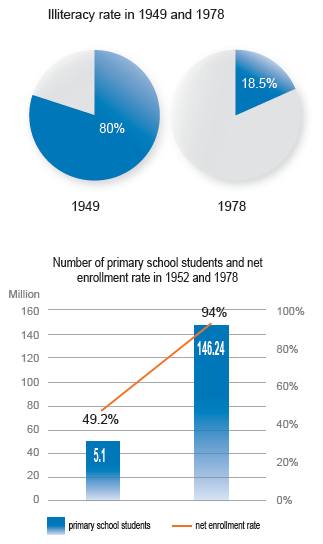
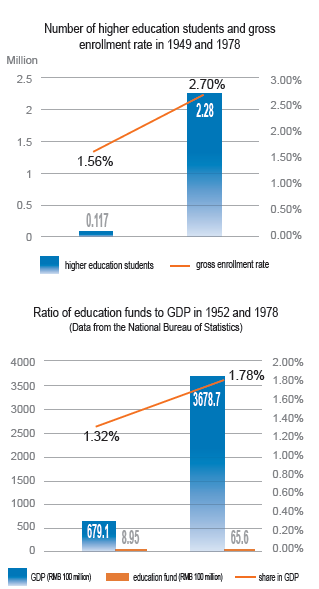
The First Session of the Chinese People’s Political Consultative Conference held in September 1949 adopted the Common Program of the Chinese People’s Political Consultative Conference, which defined the cultural and educational policy of the PRC and pointed out that “the cultural education of the People’s Republic of China is neo-democratic, that is, national and scientific cultural education of the masses.” It pointed out the direction for the recovery and exploration of education.
On October 1, 1951, the Administrative Council of the Central People’s Government promulgated the Decision on Reforming the Academic System and established the first academic system of the PRC, which has been in use ever since. From June to September of 1952, the Central People’s Government greatly adjusted the faculty setting of the national higher education institutions, and transformed the university system that emulated the British and American models before the PRC’s founding into a Soviet-style university system.
The campaign to wipe out illiteracy was also launched. On March 29, 1956, driven by the Decision on Eliminating Illiteracy issued by the CPC Central Committee and the State Council, the CPC and the People’s Government took various measures to carry out the campaign to wipe out illiteracy among the majority of workers and farmers, by adopting a variety of flexible measures such as evening classes, crash courses, newspaper reading groups, schooling during the slack season of farming in winter, and learning to read in the fields. The literacy drive achieved remarkable results. In the 15 years from 1949 to 1965, nearly 100 million young adults achieved an adequate level of literacy, and the illiteracy rate dropped rapidly to 38.10 percent.
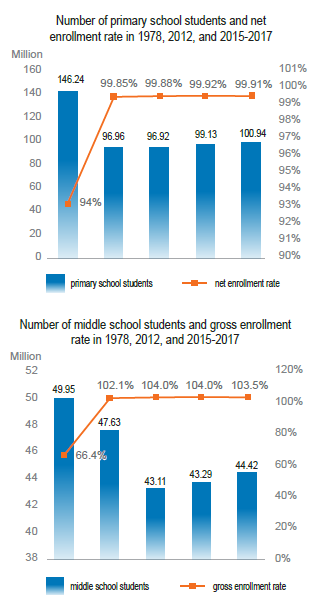

After 30 years of hard work, China basically established a relatively complete socialist education system, and made remarkable achievements in all aspects of education. In the decade between 1949 and 1958, 16 million women broke free from the shackles of illiteracy, and girls’ enrollment rate and women’s literacy rate increased significantly. Elementary education was popularized, and the net enrollment rate of primary school-age children increased from 49.2 percent in 1952 to 94 percent in 1978. Secondary education and higher education also achieved rapid recovery and development. In 1949, the number of higher education students was 117,000, which in 1978 increased to 2.28 million, an increase of nearly 20 times. The gross enrollment rate of higher education increased from 1.56 percent to 2.7 percent during the same period. Education investment has grown substantially, from RMB 895 million in 1952 to RMB 6.56 billion in 1978. It reached 1.78 percent from 1.32 percent of GDP.
1978-2019: Reform and Development
The Third Plenary Session of the Eleventh CPC Central Committee held on December 18, 1978 opened up a new pathway in the cause of socialism with Chinese characteristics.
The Party and state leaders have attached great importance to education. After resuming his work, Deng Xiaoping was in charge of education. He pointed out that the atmosphere of “respecting knowledge and respecting talents” must be formed within the Party, and required that “educational undertakings must be aligned with the requirements of national economic development.” Under the guidance of Deng Xiaoping Theory, Chinese education gradually progressed on a development path with Chinese socialist characteristics.

Students play at a boarding primary school in Maxiu Village of Qumarleb County in Qinghai Province, on August 10, 2018. The school is located in the central area of Hoh Xil, 4,500 meters above sea level in Yushu Tibetan Autonomous Prefecture.
In December 1977, the Chinese government restarted the national college entrance examination, commonly known as “Gaokao,” which had been suspended for seven years. Deng Xiao-ping successively put forward a series of important theoretical statements, including “intellectuals are part of the working class” and “science and technology are primary productive forces.” A wide-ranging discussion on the topic of “practice is the sole criterion for testing truth” and the nature of education was then carried out nationwide, and a new understanding of education as a productive force was gradually formed. It laid the ideological foundation for the reform and opening-up in the education field. In September 1983, Deng Xiaoping gave the Beijing Jingshan School the inscription, “Education should be oriented towards modernization, the world, and the future,” which defined the strategic policy of reform and opening-up in the education field.
In December 1978, China sent the first batch of 52 Chinese students financially sponsored by the government to study in the United States, ushering in a new age for China in its educational reform and opening-up. China then began to send students on a large scale to developed countries for study. In 1984, the state promulgated the policy of studying abroad at students’ own expense. The number of students studying abroad increased by more than 50 percent the following year, with the number totaling 5,000. In 1992, the central government introduced the policy for studying abroad of “supporting students and scholars studying abroad, encouraging them to return to China upon completion of their studies, and guaranteeing them the freedom of returning or not.” With China’s accession to the WTO in 2001, the following year saw the number of Chinese students studying abroad at their own expense exceed 100,000. Since 2010, the growth rate of self-funded students has begun to slow down. In 2016, the number of students studying abroad reached 544,500, with middle-class families being the main driving force. The total number of returned students reached 432,500 in 2016, accounting for 80 percent of the students studying abroad. The growth rate of returnees exceeded that of those leaving for study abroad for the first time.
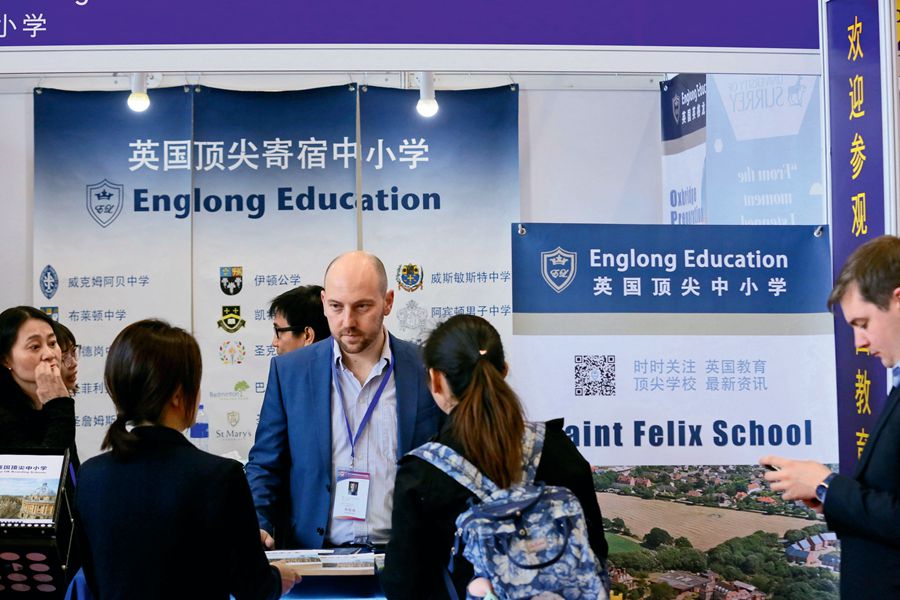
The U.K.’s top boarding primary and secondary schools participate in the 24th China International Education Exhibition Tour in Beijing on March 23, 2019.
The popularization of nine-year compulsory education provided sufficient labor for China to grow into a “world factory” and a manufacturing powerhouse in just 40 years. In 1978, primary education was basically universal, with the net enrollment rate reaching 95.5 percent. In 1986, the nine-year compulsory education kicked in across the country, and reached wide adoption in 2011. In 2017, the net enrollment rate in primary schools reached 99.91 percent, the gross enrollment rate in junior high schools reached 103.5 percent, and the consolidation rate (the proportion of the enrolled students to the graduates in the same year) of nine-year compulsory education reached 93.8 percent, which exceeded or equaled the average of high-income countries. Thanks to nine-year compulsory education, illiteracy among young and middle-aged adults has been basically eliminated. Over the past 70 years, China has wiped out illiteracy in more than 300 million people, among which over 200 million were women.
Over the past four decades, the Chinese government has put forward a range of strategies and guiding principles, including prioritizing the development of education, rejuvenating the country through science and technology, and education, reinvigorating China through human resource development, developing people-centered education, thus providing strategic guidance and motivation for the country’s education reform and opening-up. Represented by the Decision of the Central Committee of the Communist Party of China on the Reform of the Education System promulgated in 1985, China launched the reform of the education system and mechanisms based on the socialist market economic system. The legal system of socialist education with Chinese characteristics was initially established and represented by the Regulations on Academic Degrees, Compulsory Education Law, Higher Education Law, Teachers Law, and Vocational Education Law.
Educational equity, the foundation of social equity, promotes social fairness and justice. In recent years, the Chinese government has been committed to solving the issue dealing with the schooling of migrant workers’ children in cities, and has made great efforts to transform weak schools in rural areas. The central government has been sending high-quality, specially-skilled teachers to the rural, remote, and ethnic minority areas to carry out targeted poverty alleviation with education and guarantee the right to education of children with disabilities. In terms of education, the people’s sense of gain has been significantly enhanced.
At the same time, quality-oriented education has been fully implemented as quality supervision of basic education has been carried out, thus advancing the high-quality and balanced development of compulsory education. China’s higher education is about to enter the stage of popularization with continuously-improved quality. From 1978 to 2018, the number of college graduates in China increased from 165,000 to 8.2 million, a 50 fold increase in 40 years. In 1998, the Ministry of Education proposed to improve the enrollment rate of higher education to around 11 percent by the year 2000 through actively and steadily developing higher education. With the expansion of enrollment in higher education, the number of enrolled students at colleges and universities nationwide in 1998 reached 1.08 million. By 2002, the gross enrollment rate of higher education in China climbed to 15 percent, indicating that China’s higher education had entered the stage of mass accessibility. Since then, the figure has continued to grow substantially, reaching 26.5 percent in 2010 and 45.7 percent in 2017. Higher education is rapidly moving towards universalization.
Over the past 40 years, China has invested a total of RMB 36.26 trillion of funding into education, at an average annual increase of 17.1 percent. In 2016, the investment in education was RMB 3.14 trillion, accounting for 4.24 percent of GDP. China adheres to the principle of offering education of satisfactory quality by promoting education equity, and optimizing the educational structure, so as to achieve leapfrog development in all types of education at all levels. Preschool education has developed rapidly, and some areas have effectively solved the problem of kindergarten crunch. Vocational education has seen dramatic improvement, and private education has developed steadily. Special education and education of ethnic minorities has also received attention.
After the 18th CPC National Congress, the socialist education with Chinese characteristics entered a new era. General Secretary Xi Jinping of the CPC Central Committee has attached great importance to education. In the report delivered to the 19th CPC National Congress, Xi Jinping pointed out, “Strengthening education is fundamental to China’s pursuit of national rejuvenation” and we should “prioritize the development of education.” At the National Education Conference held on September 10, 2018, Xi Jinping noted, “Education is an issue of vital importance for the country and the Party,” raising the status and role of education to an unprecedented height. Under the guidance of Xi Jinping Thought on Socialism with Chinese Characteristics for a New Era, a new journey has begun in pursuit of the Chinese dream of great national rejuvenation, with the people at the center to develop education, realize education modernization, and build an education power.
China’s education development has spanned two historical periods, the first 30 years of socialist construction and the period since the country’s reform and opening-up. The two are interconnected but with significant differences, and yet in essence they are both the practical explorations of the Chinese people led by the CPC in socialist construction.
LIU FUXING is a professor of the School of Education, Renmin University of China, and Ph.D. supervisor. He was vice president of Northwest Normal University,






